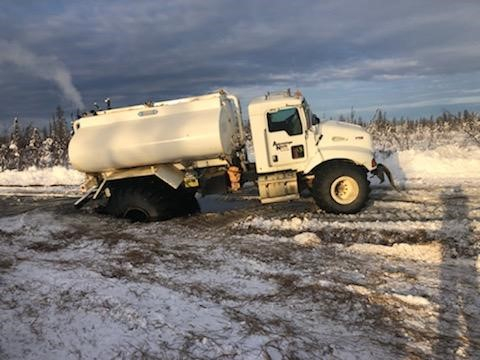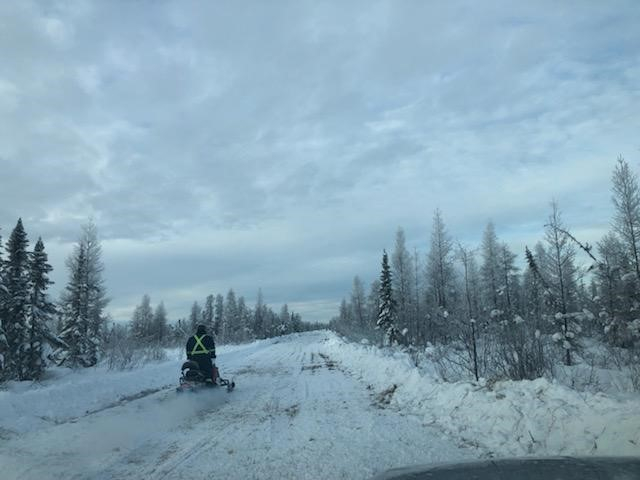What Does it Take to Build a 250 km-plus Ice Road?
The harsh realities of winter with its inevitable snow and cold can cause issues for all of us. When you are a business that depends on your equipment and assets always running safely and reliably, these issues can have a very negative impact on your bottom line. At Pieridae, we rely on our wells and pipelines to produce and deliver natural gas year ‘round, so accessing them in winter is vital.
In the remote area of Sierra/Ekwan in Northern BC, about 450 kilometers north of Dawson Creek BC, it can be incredibly difficult to reach this area when the snow starts to fly. One of the only ways to do it is to build an ice road. It may sound easy, but a lot of hard work and effort goes into the planning and construction of an ice road, and it is not without its challenges. The process of creating an ice road is called “freezing in”. This means removing snow and then freezing the ground to create a road. And we are not talking about a short distance in this area. Think of having to clear and freeze almost the entire distance from Calgary to Edmonton – a huge task! Five thousand hours of hard work in sometimes frigid conditions is needed to freeze the 260 kilometer ice road.
Why is the Ice Road Necessary?
The Ekwan area is largely filled with muskeg swamps bogs of water and dead vegetation- making it very hard to reach. In the summer, the main way in is by helicopter. Winter conditions can make helicopter travel much more dangerous, and with the amount of equipment and crews used to maintain these assets, multiple trips by helicopter are just too expensive. That means the only way to get the work done is to drive in. Without creating an ice road, vehicles would get caught in the marshes and snowbanks, making the area inaccessible without these ice roads.
Freezing In the Roads
Construction of this season’s ice road began during the first week of December and had to be finished by mid-January. The road must be tested and maintained throughout this process until it is finished. Our assets are located between Fort Nelson BC and Rainbow Lake Alberta, straddling the northern edge of both provinces. Crews start from both towns and meet near the middle to complete the project, essentially attacking it from both sides.
The first step in building the ice road is packing down the snow in preparation for clearing it all off as close to the ground as possible. Using snowmobiles, workers make multiple trips back and forth on top of the snow to pack it down, making it easier to haul away. The snow is either removed by Snowcats, or in cases where the ground is too soft for equipment, snow is hand-shoveled off the path. These machines are built to remove large amounts of snow at a time. They plow the white stuff and push it to the side, leaving a wide-open area for crews to begin the ‘freezing in’ process. The Snowcats each drag a giant tire behind them that presses down on the ground, allowing water to get to the surface and freeze over. This is known as 'driving frost into the ground.'
Crews must remove as much snow and water as possible. If too much is left, the ground will retain more heat, making the ice laid down too soft to use, or certain spots may not freeze at all. Hand shoveling snow will help any water coming to surface to be exposed to the cold and freeze over.

Once the snow is removed, it’s time to spray water along the path. The use of a floater truck is the main way to get a large amount of water down to create the road’s foundation. These large trucks drive slowly, spraying water out the back to cover a wide surface area. These are also equipped with a hose for spot filling to even out areas and help add layers of water to freeze over into ice. Depending on the area, up to two feet of ice may be needed to ensure the road is sturdy enough to hold vehicles and machinery travelling along the route.
Pieridae uses water from nearby lakes, rivers and dugouts to do the freezing in. The company gets approval from the BC Oil and Gas Commission for the amount of water it removes as we must ensure these sources of water are sustainable for years to come. In the month of December alone approximately 2.9 million liters of water was used. That’s 765,000 gallons, more than the amount of water in an Olympic-sized swimming pool!
On more difficult portions of the ice road like larger river crossings, crews make snow and lay it down for stability once the foundation is set and frozen. Using snow machines like ones you see at ski hills, they can create the snow needed for the final step in building the crossings. Using water and pressurized air to create and blow snow onto the road, crews cover it to create a flatter and more drivable surface for the winter months. These are the critical steps in the freezing in process. Once they are completed, the road needs to be tested for durability.
Dealing with Harsh Conditions
Building this ice road wasn't without other challenges for the dedicated teams who worked many hours to complete it. Crews spent around a full month working in sub 30-degree temperatures with limited daylight in remote Northern BC. Being as isolated as they were, it can be risky if crews are not properly prepared. There is no cell phone service so you don’t want to be stuck and alone. This is why Pieridae ensures workers are always in teams, using radios and satellite phones to stay in contact with one another.
Testing the Road
Testing is incredibly important to the whole process. To do this, water trucks are overloaded with water to simulate the maximum weight of heavy equipment that would typically travel back and forth on the ice road. This will give workers a good idea of whether or not the road they have built can handle the weight. One issue that can happen while they are testing is that the loaded trucks can hit a soft spot and sink. To get the heavy vehicles out, crews will use chains and a lot of force to free the truck so testing can resume.
Once the vehicle is free, the ‘soft’ spot is opened and filled with water again. This is done is a very precise manner - in layers, inches at a time – like flooding a hockey rink. The area is left for a couple days to completely freeze over so that it is once again sturdy. Testing is done in sections as the road is being built, with final analysis done using a truck filled to maximum capacity and weight to ensure the sturdiness and safety of the entire road.

A Successful Outcome
Crews had to work safely but efficiently this year as they didn’t have a lot of time to get the ice road built. The whole process began in December but needed to be finished by mid-January. If this deadline wasn’t met, access to these northern assets would be delayed, which puts the wells and pipelines at risk. These wells need winterizing and only have enough methanol to keep them flowing for one year. If crews don't get to them on time, they have a high risk of freezing to the point of shutting down. The same goes for pipelines. Without doing this winterizing, production could be completely stopped at any one of our assets up there. This time of year is also crucial for well optimization. Our well operators utilize the winter access to unload liquids that build up in wells and pipelines to maximize gas production. In addition, inspections are completed at these sites to ensure everything is operating safely and up to regulations.
The long, hard days of plowing, watering and testing the ice road demonstrates the skill and dedication workers had in getting the job done. Doing the work in bone-chilling temperatures with little daylight and having to deal with a host of potential issues makes it all the more impressive.
With the work complete, crews took a well-earned rest. Once Mother Nature begins to warm things up in the spring, the ice road will become a memory until many will do it all over again next winter. For a road that is built in a short period of time, a full year of planning and analysis is needed before a shovel hits the ground. Preparation for the 2022/23 edition of the ice road will start before this season’s ice road even melts. Engineers will look for ways to potentially build a shorter ice road, and do additional winterizing of certain wells and pipelines this year to last an extra season. The process of getting permits for the amount of water that will be used begins this summer, with crew selection and picking the day to begin constructions for the next iteration of the ice road happening in early November.